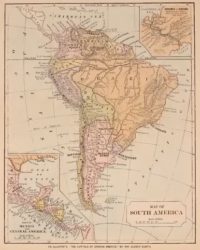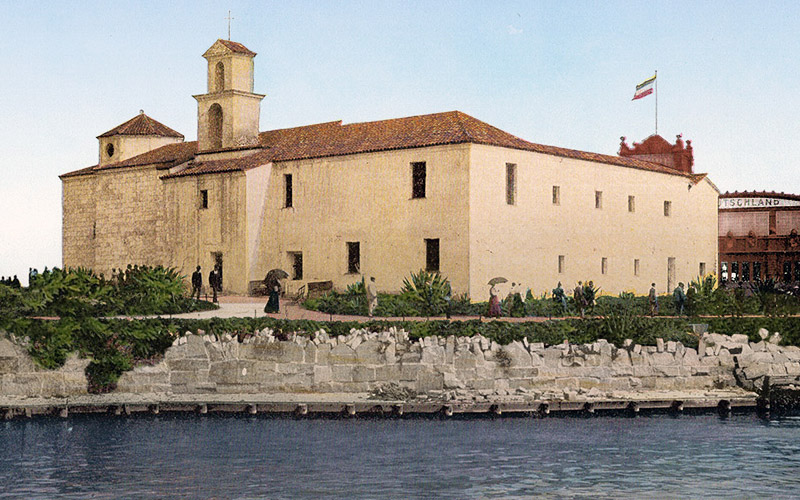Today marks the anniversary of the birth of William Eleroy Curtis, born on November 5, 1850, in Akron, Ohio. Curtis served the 1893 World’s Columbian Exposition as the chairman of the Latin American Department and representative of the State Department for the U.S. Government Exhibit.
Curtis was a journalist and traveling correspondent for the Chicago Inter-Ocean and the Record-Herald newspapers and authored more than thirty books, many about his travels and research in South America.
For the Exposition, Curtis was charged with integrating “Pan-Americanism” into the Fair. He headed a mission to Latin America in 1891 to encourage participation of other nations of the Americas. All agreed to send exhibits to Chicago, and six of them (Brazil, Columbia, Costa Rica, Ecuador, Guatemala, and Nicaragua) built national pavilions on the grounds.
Curtis’s two most visible contributions to the 1893 World’s Fair could be viewed in the southeast corner of the fairgrounds and were among the most popular attractions at the Fair.

A map of South America from William E. Curtis’ Capitals of Spanish America (Harper, 1888).
La Rabida
The first attraction was a reproduction of the ancient Convent of La Rabida, filled with an extraordinary collection of historical Columbiana artifacts and records.
“The idea of constructing this edifice, and of collecting in it the relics of Columbus, was the thought of William Eleroy Curtis, of the Bureau of American Republics, who traversed the whole of Europe searching for traces of the great Genoese Admiral, and procuring relics, maps, etc., for exhibition here,” writes White and Igleheart in their Columbian Exposition history. “He is probably the best authority on this continent concerning everything connected with Columbus. Mr. Curtis has written entertainingly of the Convent and its site.”
Curtis cataloged the exhibits housed inside La Rabida in his commemorative volume The Relics of Columbus: An Illustrated Description of the Historical Collection in the Monastery of La Rabida (William H. Lowdermilk Company, 1893). The display consisted of eighteen sections:
Section A. Geographical Knowledge and the Science of Navigation at the Time of Columbus.
Section B. The Court of Ferdinand and Isabella
Section C. The Birth and Early Life of Columbus
Section D. The Career of Columbus in Spain
Section E. Scenes Associated with the First Voyage
Section F. Scenes Associated with the Second Voyage
Section G. Scenes Associated with the Third Voyage
Section H. Scenes Associated with the Last Voyage
Section I. The Last Days of Columbus. His Death and Burial
Section K. The Relics- of Columbus
Section L. The Publication of the Discovery
Section M. The Christening of the Continent, etc.
Section N. The Conquest of Mexico and Peru, and the Settlement of Other Portions of America
Section O. Original Papers Relating to Columbus Loaned by the Duke of Veragua
Section P. Original Papers Relating to Columbus Loaned by the Duchess of Berwick and Alba
Section Q. The Vatican Exhibit
Section R. The John Boyd Thacher Collection of Valuable Works Relating to Columbus and the Discovery
La Convent of La Rabida [Image from Picturesque World’s Fair. An Elaborate Collection of Colored Views (W. B. Conkey, 1894).]
The Spanish Caravels
The second exhibit spearheaded by Cutis consisted of reproductions of Columbus’s three Spanish caravels, the flagship Santa Maria and the Pinta and the Nina. White and Igleheart describe the display of ships:
“In the south pond of the Exposition grounds are moored the reproductions of the three Spanish caravels which bore the crew of Columbus on his first voyage. In a plan for a historical exhibit at the Exposition which was prepared by Mr. Curtis, it was proposed to reproduce in fac-simile the fleet of Columbus and anchor them off the shore at Jackson Park during the Exposition in such a manner as to place them in contrast with the model battle-ship which represents the naval architecture of this century. The Spanish government co-operated in this effort, and after months of study plans were prepared by a board of naval architects and archaeologists appointed by the Spanish Minister of Marine for the reproduction of the Santa Maria, which was the flagship of Columbus, and the Pinta, and the Nina, which composed his fleet. The caravels were constructed at Barcelona and Cadiz. The flagship was built at the expense of the Spanish government, and the other two at the expense of the United States. The ships made their first public appearance at Huelva, Spain, on the 12th of October, 1892, and were then visited by the Queen and royal family, and by thousands of visitors. On the 19th of February the vessels started for America, following as near as possible the course of Columbus. They were delivered to the Spanish authorities at Havana about the middle of March, and were manned and used by them during the naval review at Hampton Roads and New York. They were then towed to Chicago and anchored off the Exposition grounds, where they attract great attention. After the Fair they are to be presented by the Spanish government to the United States and will remain permanently in this country.”
The caravels did remain in the harbor next to Jackson Park for many years after the 1893 World’s Fair. The Pinta sank in 1918, the Nina burned in 1919, and the dilapidated Santa Maria was destroyed in 1925.
“The Caravels and La Rabida” color plate by Charles S. Graham from The World’s Fair in Water Colors. (Mast, Crowell, and Kirkpatrick, 1893.)
The tie that will bind the American republics
Due to his expertise in Latin American and desire for improved relations between the North and South America, William E. Curtis was appointed Secretary of the South American Commission in 1886 and served as Director of the Bureau of the American Republics (later called the Pan American Union) from 1890-1893.
In the early 1890s, the American Press Association invited seventy-four notable Americans to make predictions about American life in 1993, as a way of generating interest in the upcoming 1893 World’s Columbian Exposition in Chicago. Curtis contributed this vision:
“The manifest destiny of the United States is to dominate the American hemisphere. This will be accomplished not by political intrigue, not by diplomatic negotiations, not by the force of arms, not by the annexation of territory, and not by the establishment of protectorates — but by the influence of example and by commercial relations. The tie that will bind the American republics and colonies will by the tie of trade. And in 1993 American commerce, to a very large degree, will be confined to American waters.”
_____________________________________________________________________
SOURCES
Cassell, Frank A. “The Columbian Exposition of 1893 and United States Diplomacy in Latin America” Mid-America 67 (October 1985): 110-24.
Coates, Benjamin A. “The Pan-American Lobbyist: William Eleroy Curtis and U.S. Empire, 1884–1899” Diplomatic History, 38 (1), 1 January 2014, 22–48.
Curtis, William Eleroy The Capitals of Spanish America. Harper, 1888.
Curtis, William Eleroy “United States to Dominate the Hemisphere.” reprinted in Today Then: America’s Best Minds Look 100 Years into the Future on the Occasion of the 1893 World’s Columbian Exposition complied by Dave Walter. American and World Geographic Publishing , 1992.
Rydell, Robert W.; Findling, John E.; Pelle, Kimberly Fair America: World’s Fairs in the United States. Smithsonian Institution Press, 2000.
White, Trumbull; Igleheart, William The World Columbian Exposition, Chicago, 1893. J. W. Ziegler, 1893), Chapter 19 “La Rabida Convent: Relics of Columbus and Queen Isabella.”

